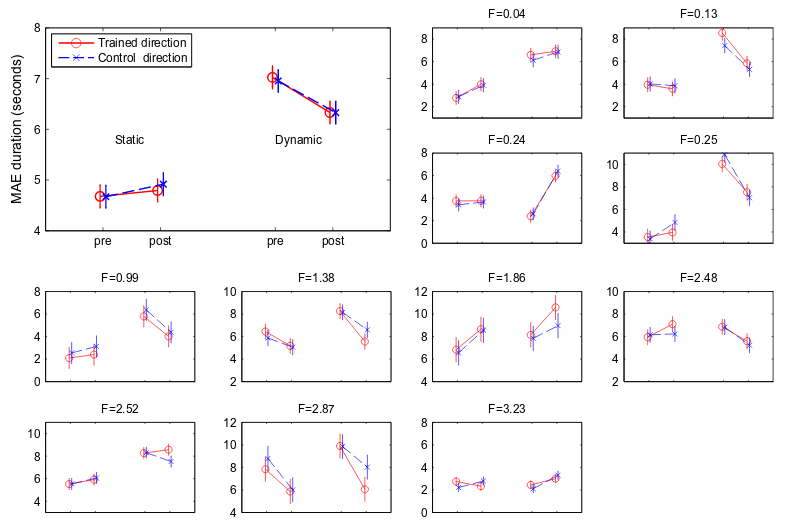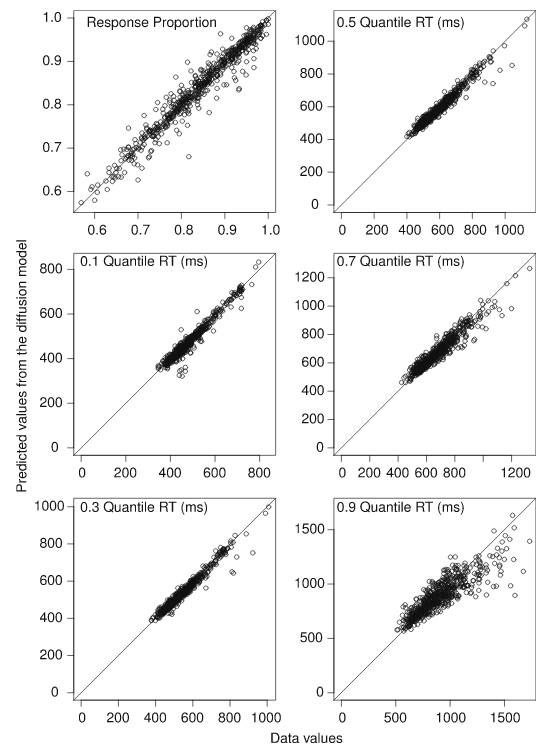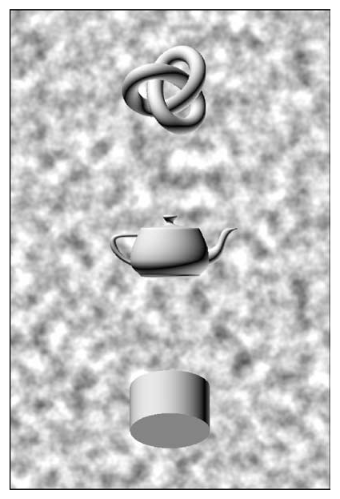Research
Visual Perception Research
- Motion aftereffect duration is not changed by perceptual learning: Evidence against the representation modification hypothesis (PDF):

The representation modification hypothesis of perceptual learning attributes the practice-induced improvements in sensitivity and/or discriminability to changes in the early visual areas. We used motion aftereffects (MAE) to probe the representations of motion direction. In two experiments, four practice sessions on a fine direction-discrimination task caused large stimulus-specific improvements in d0 but no significant stimulus-specific changes in either static or dynamic MAE duration at posttest relative to a pretest. Power analysis indicated that the data were approximately 100 times more likely given the hypothesis of no MAE change than the hypothesis of a 10% relative change. In light of converging evidence in the MAE literature, this suggests that little or no change occurred in the cortical representations of visual motion up to and including area MT. The task specificity of the learning effect challenges the representation modification hypothesis and supports an alternative—selective reweighting.
Dissociable perceptual-learning mechanisms revealed by diffusion-model analysis (PDF):

Performance on perceptual tasks improves with practice. Most theories address only accuracy data and tacitly assume that perceptual learning is a monolithic phenomenon. The present study pioneers the use of response time distributions in perceptual learning research. The 27 observers practiced a visual motion-direction discrimination task with filtered-noise textures for four sessions with feedback. Session 5 tested whether the learning effects transferred to the orthogonal direction. The diffusion model (Ratcliff, Psychological Review, 85, 59–108, 1978) achieved good fits to the individual response time distributions from each session and identified two distinct learning mechanisms with markedly different specificities. A stimulus-specific increase in the drift-rate parameter indicated improved sensory input to the decision process, and a stimulus-general decrease in nondecision time variability suggested improved timing of the decision process onset relative to stimulus onset (which was preceded by a beep). A traditional d’ analysis would miss the latter effect, but the diffusion-model analysis identified it in the response time data.
- The visual identification of relational categories (PDF):

An experiment was performed to investigate the ability of human observers to identify configural relations among three dots. Four stimulus categories were defined on the basis of whether or not the dots were arranged collinearly and whether or not the central dot was equally spaced relative to the two flanking dots. Observers were initially trained with feedback to identify these categories at a single orientation with a fixed uniform background, and then they were tested with variable orientations and backgrounds without feedback. The results revealed almost perfect generalization. We also simulated the same task using a recent feature hierarchy model (J. Mutch & D. G. Lowe, 2008) that is among the most successful for object recognition. This model performed well for fixed orientations and backgrounds, but it could not accurately identify these categories with variable orientations and backgrounds even when given training with those conditions. These findings suggest that feature hierarchy models represent the spatial relations within an image quite differently than human observers.
Software Applications
- MassMine

MassMine is a grant funded social media mining and archiving application that simplifies the process of collecting and managing large amounts of data across multiple sources. It is designed with the researcher in mind, providing a flexible framework for tackling individualized research needs. MassMine is designed to run both on personal computers and dedicated servers/clusters. MassMine handles credential authorizations, data acquisition & archiving, as well as customized data export and analysis. Information about the MassMine project can be found at the official project site: www.massmine.org.
jsan
The JSON Swiss Army k*N*ife. Convert, subset, repurpose, and otherwise extract information in JSON streams/files from the command line
jsan provides extraction of data from JSON streams (from file or standard input) and returns (to file or standard output) the result in user-customizable format. A common application is to convert JSON-encoded data into comma separated values (CSV) format. Conversion is fast and does not consume memory, allowing for conversion of arbitrarily large (or endlessly streaming) JSON files. Data fields can optionally be filtered during conversion so that only desired fields are retained in the resulting output.
Because jsan can also write to standard output, it can also serve as a useful exploration tool for quickly exploring JSON data (e.g., pulling user names across all entries). Output can be piped to other common command line tools (e.g., awk) as in traditional unix-like workflows. Downloads and usage instructions are available at my github repository.
Libraries, Packages, etc.
- Data Science Racket Package

The Data Science package provides a suite of convenience functions for data science in Racket (a scheme-like programming language): data cleaning, wrangling, summarizing, and exploration, as well as sentiment analysis, singular value decomposition, linear modeling, and other solutions for analysis problems. The software package is inspired by functionality commonly available in more statistically-oriented software packages such as R, numpy/scipy, and Matlab/Octave.
Emacs Cyberpunk Color Theme
Cyberpunk color theme for the Emacs 24+ built-in theme support known loosely as deftheme. I created this initially as a port of the overtone/emacs-live theme of the same name (designed for the color-theme package), but it has grown to support many additional mode-specific customizations. The code, installation instructions, and screenshots are available at my github repository.
Clucker: A Twitter API package for Chicken Scheme
Chicken Scheme “egg” (i.e., package) that provides access to Twitter’s streaming and RESTful API endpoints. See the clucker repository for more info.
Chicken Scheme String Egg “s”
String manipulation egg for chicken scheme. The s egg aims to provide many convenient procedures for working with strings. Some of these functions are simply wrappers around existing scheme procedures. In the spirit of s.el, such wrappers exist to provide users with a consistent API for quickly and easily manipulating strings in Chicken Scheme without searching documentation across multiple modules. Check out the s egg repository for more info.
- For other projects, check out my Github page for some of my work.